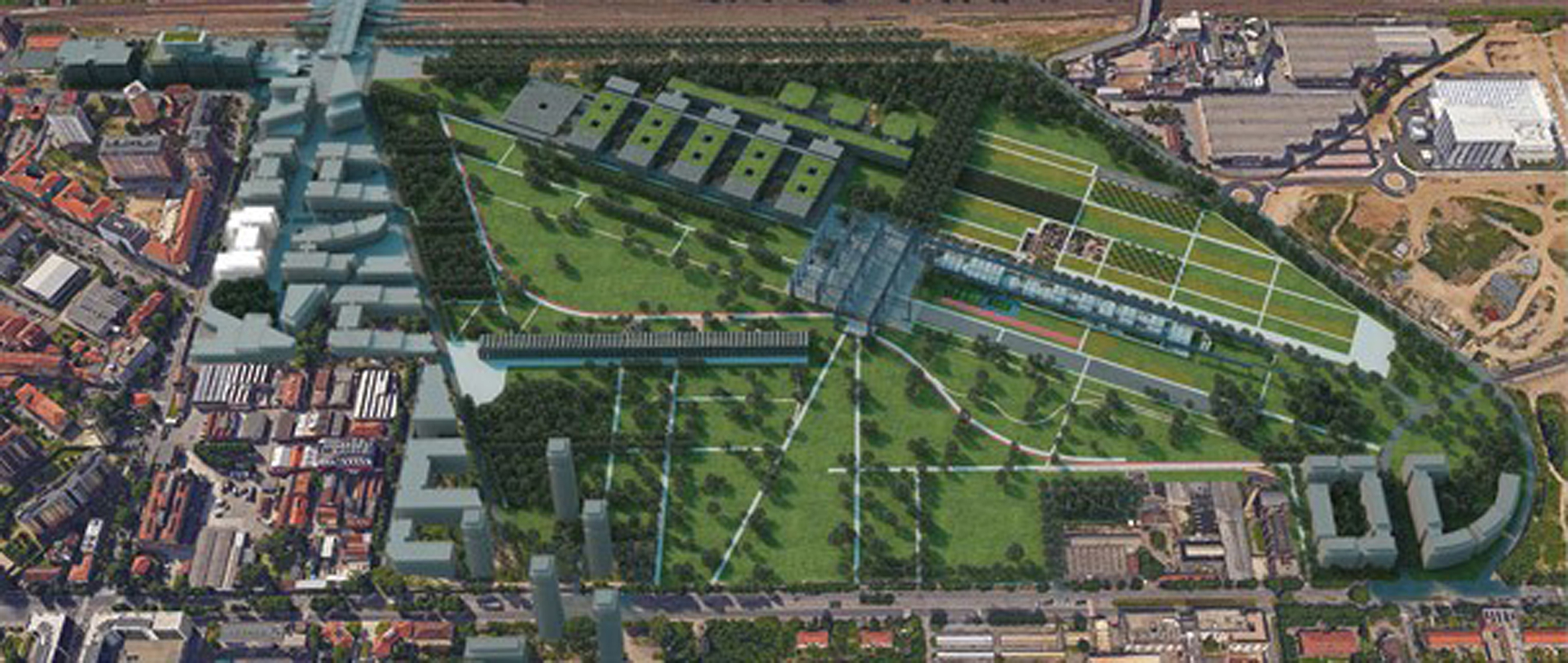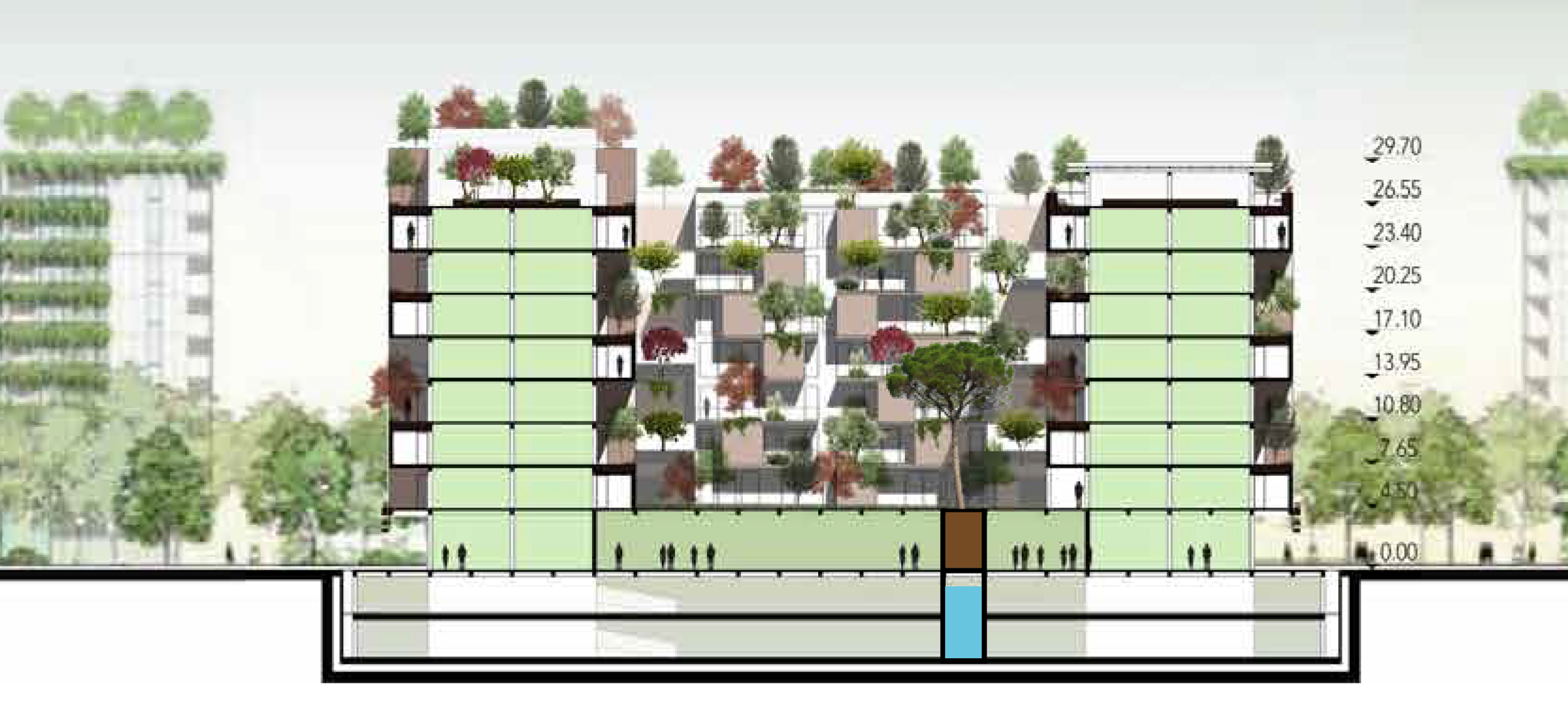HOUSE IN MILANOSESTO
TERRAZZA ALL’ITALIANA
“Viste dal parco le nuove edificazioni si presenteranno come una articolata successione di pattern regolari sui quali sarà eventualmente possibile immaginare una forte presenza di elementi vegetali in facciata e sulle coperture.” (Renzo Piano)

Su questa dichiarazione del progettista artefice del Master Plan si basa una parte fondamentale del progetto. Si è scelto di adottare alla lettera le indicazioni che suggeriscono una precisa impronta e volumetria dell’edificio da progettare. Si sono quindi rispettati implicitamente i valori di area, volumetria e distacchi richiesti dal bando.
Il progetto prevede circa 5000mq per i due livelli di parcheggi richiesti con un totale di circa 150 posti auto. L’area commerciale di oltre 1100 mq offre i diversi tagli dai 500mq ai 250mq richiesti. La superficie residenziale su un totale di circa 12000mq offre un totale di 114 appartamenti nei diversi tagli da 65mq per il bilocale, 90mq per il trilocale e 120 mq per il quadrilocale
Due temi fondanti hanno guidato le scelte progettuali: un autentico principio di sostenibilità ambientale e un ridisegno della cellula abitativa tradizionale.
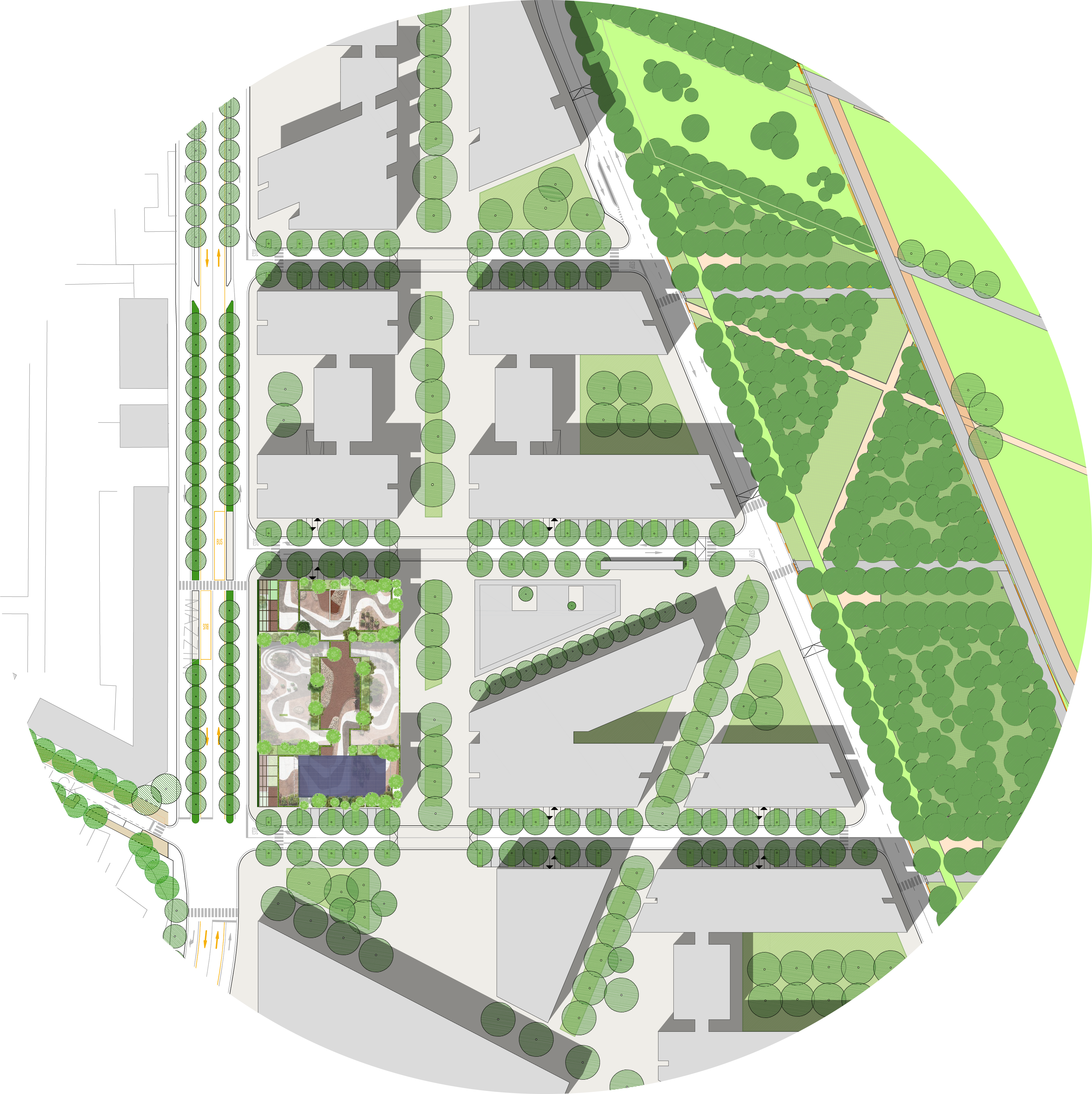
Il Principio di sostenibilità ambientale passa attraverso una possibile alternativa alle consuete tecnologie edilizie di costruzione, immaginando una struttura in legno lamellare portante, oggi valida opzione anche per edifici multipiano di queste dimensioni, e l’uso esteso di coperture a verde con enormi benefici ambientali, confort abitativo e dal forte impatto nel paesaggio urbano.
Ripensare la cellula abitativa dall’esterno verso l’interno, attraverso una rivoluzione del classico spazio residenziale partendo proprio dall’area più privata della casa: il ‘’Bagno’’. Si persegue l’idea del superamento di una regola ormai consolidata, che vede questo spazio un accessorio necessario ma sacrificabile, utile a coprire vuoti bui e poco areati, frutto di una scarsa immaginazione.
La migrazione del bagno verso l’esterno porta a sorprendenti risultati. Il primo dei quali è rappresentato da uno ‘’svuotamento’’ dello spazio abitativo interno con effetto di una maggiore flessibilità spaziale all’ interno delle singole cellule abitative, lasciando spazio alla progettazione degli interni. Non più bagni bui con areazione forzata ma tutti con accesso diretto all’esterno come una stanza normale.
La possibilità di sfruttare, il dislivello tra l’altezza minima del solaio interno del bagno, e l’altezza del solaio residenziale, produce un gap importante. È un’occasione unica per immaginare la copertura dell’intero bagno, che potrà dilatarsi ancora accoppiando i bagni o aggiungendo una cabina armadio.
La rivisitazione della “terrazza”, peculiarità della palazzina italiana, si trasforma quindi nel occasione di ripensare lo spazio residenziale, un piccolo giardino pensile, naturale estensione del soggiorno, capace di accogliere quasi per la sua interezza un vero e proprio angolo di vegetazione una piccola oasi naturale. Piantumazioni non più relegate in fioriere o vasi ma parte integrante della terrazza uno spazio dove sostare a piedi nudi sull’erba.
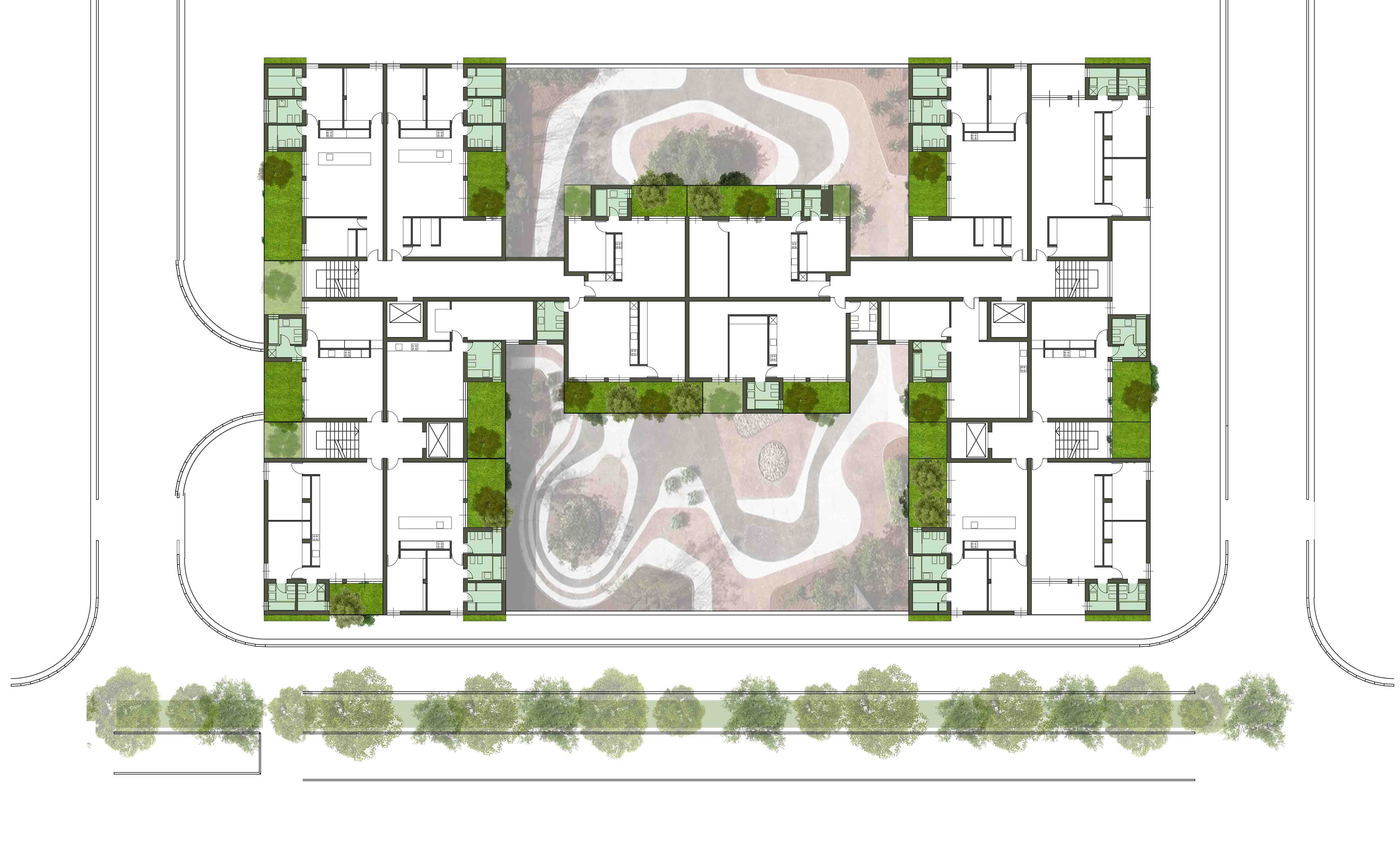 Si è cercato di dare in questo modo a tutte le unità abitative un luogo intimo per stare all’ aperto e un doppio affaccio capace di aumentare la ventilazione naturale.
Si è cercato di dare in questo modo a tutte le unità abitative un luogo intimo per stare all’ aperto e un doppio affaccio capace di aumentare la ventilazione naturale.

La facciata esterna svela la sua natura di giardini pensili multipiano che danno vita ad un gioco di luci e ombre, preziose in inverno e ristoratrici d’estate. Una quinta urbana che muta col passare delle stagioni, un polmone verde che ben si sposa con il concetto di recupero e rigenerazione del quartiere.
L’insieme delle terrazze pensili, la copertura del piano commerciale e la copertura dell’edificio stesso rappresentano un unico “sistema tetto giardino” che promuove l’uso del verde in modo diffuso.
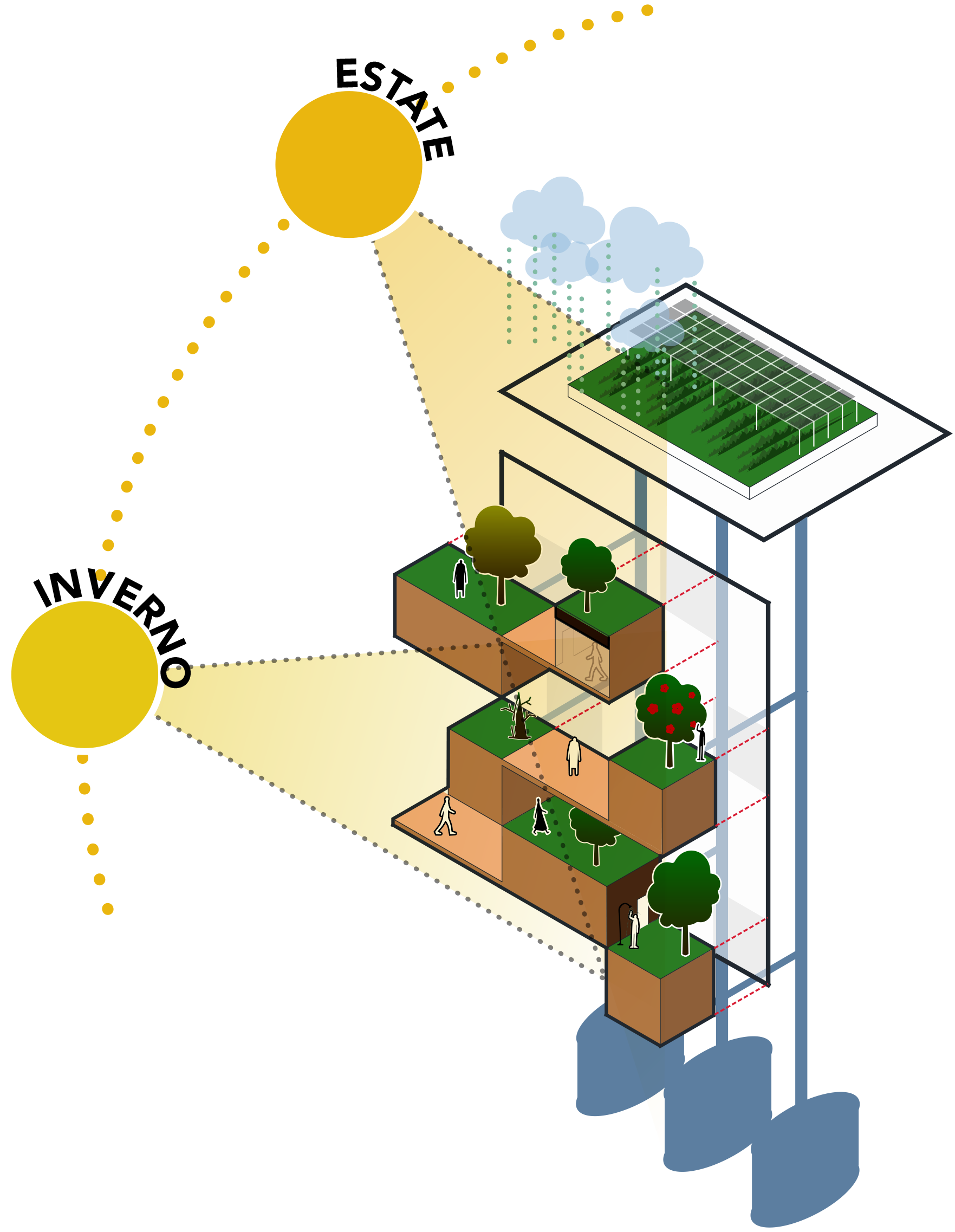
MILANOSESTO URBAN REGENERATION COMPETITION
ITALIAN TERRACE
“Seen from the park, the new buildings will be presented as a complex succession of regular patterns on which it will eventually be possible to imagine a strong presence of plant elements on the façade and on the roofs.” (Renzo Piano)
A fundamental part of the project is based on this declaration by the designer responsible for the Master Plan. It was decided to adopt the indications that suggest a precise imprint and volume of the building to be designed. The area, volume and detachment values required by the notice were therefore implicitly respected. The project foresees about 5000 square meters for the two levels of parking required with a total of about 150 parking spaces. The commercial area of over 1100 square meters offers the different cuts from 500 square meters to 250 square meters required. The residential area of approximately 12000sqm offers a total of 114 apartments in different sizes of 65sqm for the two-room apartment, 90sqm for the three-room apartment and 120sqm for the four-room apartment.
Two fundamental themes have guided the design choices: an authentic principle of environmental sustainability and a redesign of the traditional living cell.
The principle of environmental sustainability goes through a possible alternative to the usual building technologies of construction, imagining a load-bearing lamellar wood structure, today a valid option also for multi-storey buildings of this size, and the extensive use of green roofs with enormous environmental benefits, living comfort and a strong impact on the urban landscape.
Rethinking the living cell from outside to inside, through a revolution of the classic residential space starting from the most private area of the house: the ‘’ Bath ’’. Overcoming a consolidated rule that sees this space as a necessary but expendable accessory, useful to cover dark and poorly ventilated voids, is the result of a poor imagination.
“Bathroom migration” to the outside leads to surprising results. The first of which is represented by an “emptying” of the internal living space with the effect of greater spatial flexibility within the individual living cells, leaving space for the interior design. No more dark bathrooms with forced ventilation, but all with windows, lighting and natural ventilation and direct access to the outdoor terrace like a normal room.
The possibility of using the difference in height between the internal floor of the bathroom and the height of the residential floor produces an important gap. It is a unique opportunity to imagine the coverage of the entire bathroom, which can still expand by adding the bathrooms or adding a walk-in closet.
The revisitation of the “terrace”, a peculiarity of the Italian building, is therefore transformed into the occasion to rethink the residential space a small hanging garden, a natural extension of the living room, capable of accommodating almost in its entirety a real corner of vegetation, a small natural oasis. Plantings no longer relegated to planters or vases but an integral part of the terrace where you can stand barefoot on the grass.
In this way we have tried to give all the housing units an intimate place to be outdoors and a double facing capable of increasing natural ventilation.The external façade reveals its nature of multi-storey hanging gardens that give life to a play of lights and shadows, precious in winter and refreshing in summer. An urban backdrop that changes with the passing of the seasons, a green lung that goes well with the concept of recovery and regeneration of the neighborhood.
The hanging terraces, the roof of the commercial floor and the roof garden of the building itself represent a single “roof garden system” that promotes the use of green in a widespread way.
Tipologia: mix residenziale e commerciale
Luogo: Sesto Sangiovanni Milano
Anno: 2017
Team: Valerio Cruciani, Federica Cecchi, Michele Devito, Angelica Runkel, Marta giannini, Silvia D’alessandro, Silvia Austeri.

